|
|
|

Euphorbia susannae
This is a great little plant and one of the most beautiful and
most characteristic species of the genus Euphorbia.
|
|
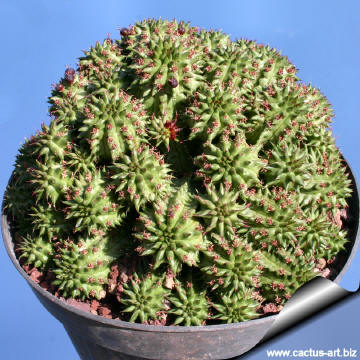 |
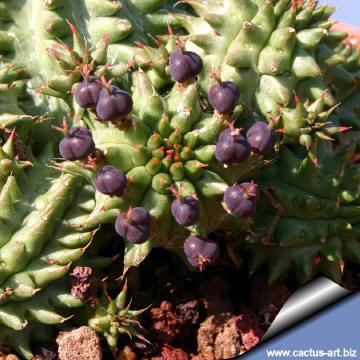 |
|
. |
|
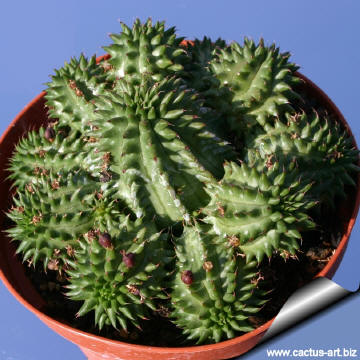 |
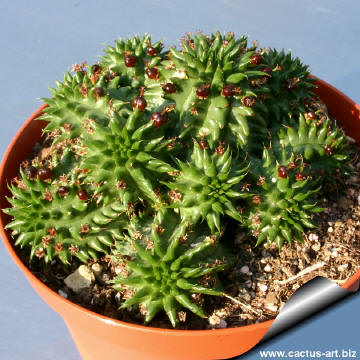 |
Warning: As with all other Euphorbias when a plant get damaged it
exudes a thick white milky sap known as latex. This latex is
poisonous and particularly dangerous for the eyes, skin and
mucous membranes. So pay extreme attention not to get
any in your eyes or mouth. Cultivated plants must be handled
carefully.
|
|


Advertising
|
|
|
|
|
Family:
Euphorbiaceae
Scientific name:
Euphorbia susannae Marloth (also suzannae
)
This species was discovered
in 1925 by Dr. John Muir and was described 4 years later by Dr. Marloth.
Origin: It
is endemic to a few limited areas in little Karroo. Landsmith district,
Cape Province, South Africa
Habitat: They grows
in small population, sometime with only a few individual on very sandy
and stony ground, often with white quartz on the surface. They are found
either on open places or partially under the shade of small bushes. Most
of the plants are cryptic (grows completely underground with only the
tips of the stems above the ground level) while some grow totally above
the ground and are shaped like a half-sphere or a cushion (like in
cultivation).
Conservation status: Listed in
CITES appendix 2.
Etymology: It was was
named after Dr. Muir 's wife: Susanna, the wife of the
discoverer of this species. By the way, this woman's name was (according
to some writers) Suzanna, with a z, and named the plant Euphorbia
suzannae.
|
|
Description: Small
clumping or (rarely) solitary succulent, that forms nice hemispherical
clumps up to 10 cm tall and 3o cm in diameter. It grows relatively fast
for a small so small sized plant.
Stems: Prominently tubercled, harmless, green to dirty brown/green,
12 to 16 angled. It produces a host of branches from the central
roundish base (caudex). It grows apically
and upward of course, but the stems are dragged downward by contractile
action, probably seated in the roots.
Leaves: Reduced to short bristles on the young stems.
Flowers: Green or brownish cyathias in the fall or spring
Hybrids:
This species given rise to one
of the of the top euphorbia hybrids (E. susannae x E.
bupleurifolia) The stems are fat and globular like susannae
while the leaves are bluish and channelled like bupleurifolia.
|
|
|
|
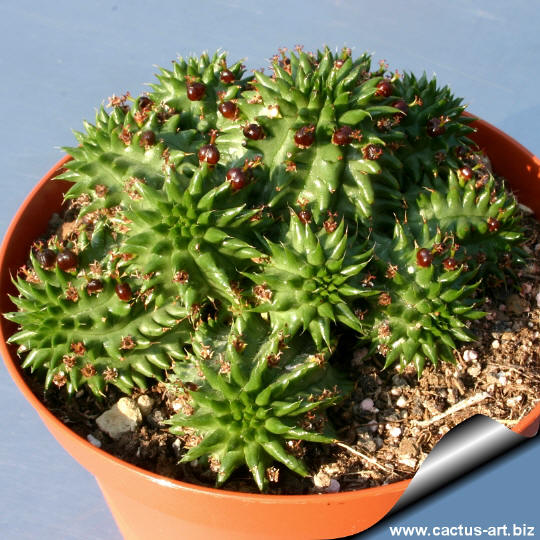
Cultivation:
Euphorbia susannae is one of the
best and simplest Euphorbias for pot culture.
This species is dormant in
winter and can be watered moderately all year
around (except in the coldest month of the winter as it rot
easily). It do not love
the blasting heat, and plants grown in full sun tend to yellow and burn
a bit. Often the loss of this plant can be blamed on the use of soil
that doesn't permit the water pass trough enough. Another reason can be
a standing-place in the full sun without a good ventilation.
Mature healthy plants are tough and can also be grown out of where frost
is not too severe, it can tolerate temperatures down -4°C (-10° C if the
roots are kept dry) it is
also suited for neat xeriscape gardens but never looks perfect like it
does kept in a pot in a protected environment
Propagation: Seeds
(give nicer young plants) or cuttings. Moreover a cutting will grow into
a typical plant which can not be distinguished from a seedling when it
gets older.
Germination occurs within 3 weeks. It tend to branch enthusiastically
and offsets are readily available, if you remove an offset, remember to
let it dry for a week or so, letting the wound heal (cutting planted to
soon easily rot before they can grow roots). It is better to wash the
cut to remove the latex.
Note: This species has a particular tendency to produce cristated
stems. Sometimes these cristates are completely or almost completely
without chlorophyll . These plants can only be multiplied by cutting.
Photo of conspecific taxa, varieties, forms and cultivars of
Euphorbia susannae.
|
|